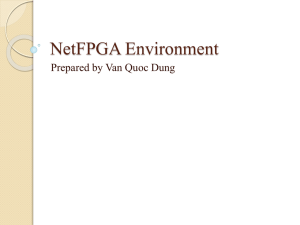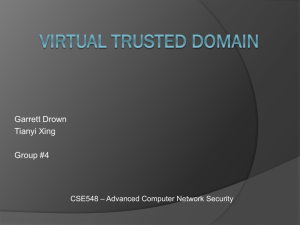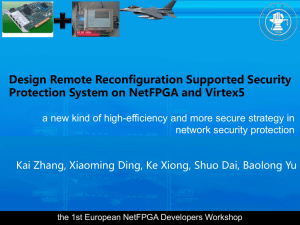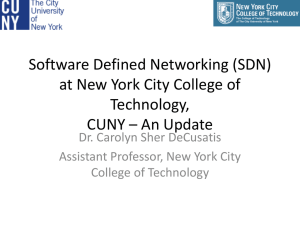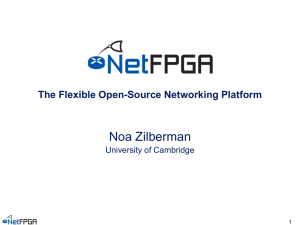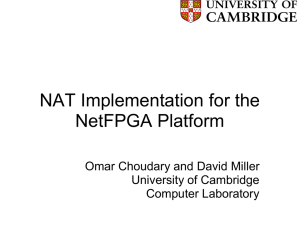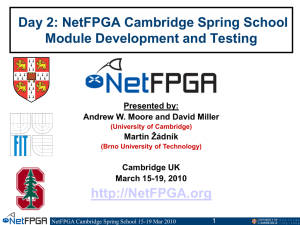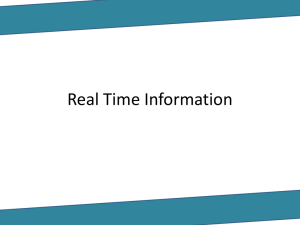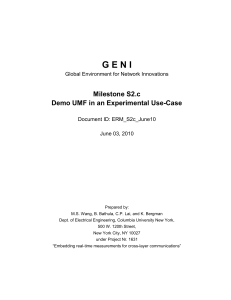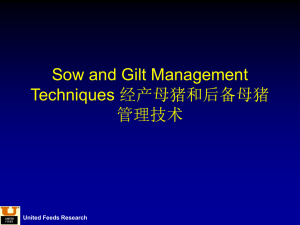PPT
advertisement
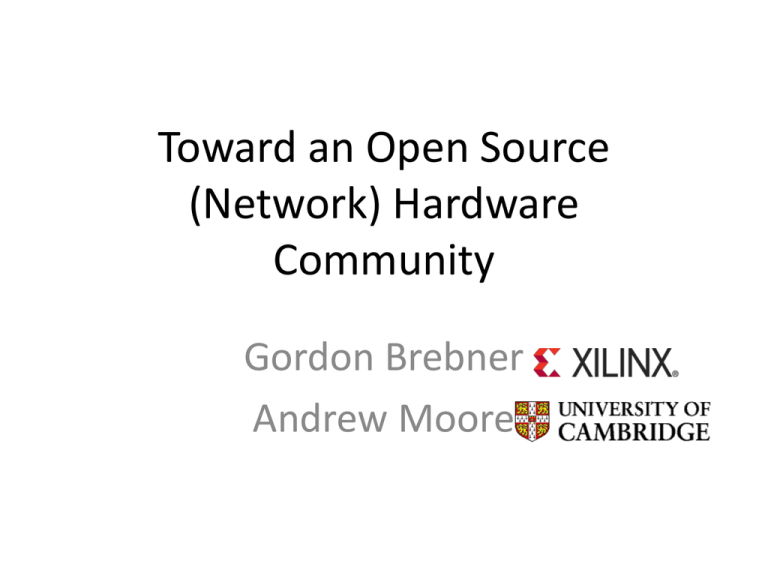
Toward an Open Source (Network) Hardware Community Gordon Brebner Andrew Moore Goals • Enable people to build interesting networking systems with FPGA-based implementations • Allow people to focus on their particular areas of networking expertise and interest • Provide lightweight coordination to share expertise in a systematic way Before and After NetFPGA 1G NetFPGA 10G Increase FPGA type Virtex-II Pro 50 Virtex-5 TXT 240 Lookup tables 47232 4-LUTs 149760 6-LUTs x 4.76 Flip-flops 47232 149760 x 3.17 Block RAM 4176 Kb 11664 Kb x 2.79 Tri-mode MACs 0 4 ∞ Implication • NetFPGA 1G: – Usually produce single-function reference designs – Typically based on IP router example • NetFPGA 10G – Space to build more complex systems – More motivation for repository of reusable blocks • Get some components from the repository • Contribute new components to the repository Needs • Standard interfaces for hardware components to maximize reuse and “plug and play” – ARM’s AMBA AXI4 has been chosen • Planned collection of contributed networking components that provides wide coverage of functions and are produced by specialists • Be agnostic about how individual components are designed – tools and languages – Provide tool support for building systems Thoughts on core projects • Monitoring core (high quality timestamps) – Feeds capture card – Feeds benchmarking (development cycle for most apps) – Feeds traffic generator/receiver test rig – Feeds an ieee1588 appliance All this depends on modules with good interface definition – part of the NetFPGA 10G process has been to get the interface right too… Example Modules • NetThreads (CPU) – Toronto – Feeds Traffic Generator (for example) • High precision time stamp – Cambridge – Feeds Capture card (for example) • Traffic Manager – QUB (Belfast) – Feeds virtualizable NIC with QOS (for example) • IPv4 Reference Router (meta module) - Stanford along with Reference NIC and Ethernet switch How might we use NetFPGA? • • • • • • • • • • • • • • • • • • • • • • • • • • • • • • Build anI’m accurate, line-rate NetDummy/nistnet Well notfast, sure about you butelement here is a list I created: • Hardware channel bonding reference implementation TCP sanitizer A flexible home-grown monitoring card • Evaluate Buildnew an accurate, fast, line-rate NetDummy/nistnet element • Other protocol sanitizer (applications… UDP DCCP, etc.) packet classifiers – (and application classifiers, and other neat network apps….) • Full and complete Crypto NIC • Prototype A flexible monitoring card a fullhome-grown line-rate next-generation Ethernet-type • IPSec endpoint/ VPN appliance Trying any of Jon Crowcrofts’ ideas (Sourceless IP routing for example) • VLAN reference implementation • Demonstrate Evaluatethe newwonders packet classifiers of Metarouting in a different implementation (dedicated hardware) • metarouting implementation – hardware (and application and other neat network apps….) Provable (using aclassifiers, C# implementation and kiwi with NetFPGA as target h/w) • virtual <pick-something> Hardware supporting Virtual Routers • intelligent proxy • CheckPrototype full line-rate next-generation that somea brave new idea actually worksEthernet-type • application embargo-er e.g. Rate Control Protocol (RCP), Multipath TCP, • Layer-4 gateway • toolkit Trying any of Jon Crowcrofts’ ideas (Sourceless IP routing for example) for hardware hashing • h/w gateway for VoIP/SIP/skype MOOSE implementation • h/w gateway for video conference spaces • IP address Demonstrate the wonders of Metarouting in a different implementation (dedicated hardware) anonymization • security pattern/rules matching SSL decoding “bump in the wire” • Anti-spoof traceback implementations (e.g. BBN stuff) • Xen specialist Provable nic hardware (using a C# implementation and kiwi with NetFPGA as target h/w) • IPtv multicast controller computational co-processor • Intelligent IP-enabled device controller (e.g. IP cameras or IP powe • Distributed Hardware supporting co-processor Virtual Routers computational • DES breaker IPv6 anything • platform for flexible NIC API evaluations • IPv6 –Check that some brave new6over4, idea actually works IPv4 gateway (6in4, 4in6, 4over6, ….) • snmp statistics reference implementation Control Protocol (RCP), Multipath TCP, Netflowe.g. v9Rate reference • sflow (hp) reference implementation PSAMP reference • trajectory sampling (reference implementation) • IPFIX toolkit for hardware hashing reference • implementation of zeroconf/netconf configuration language for ro Different driver/buffer interfaces (e.g. PFRING) • h/w openflow and (simple) NOX controller in one… • or “escalators” MOOSE implementation (from gridprobe) for faster network monitors • Network RAID (multicast TCP with redundancy) Firewall reference • inline compression • GPS packet-timestamp IP address anonymization things • hardware accelorator for TOR High-Speed Host Bus Adapter reference implementations • load-balancer • – SSLInfiniband decoding “bump in the wire” • openflow with (netflow, ACL, ….) – iSCSI • reference NAT device Myranet • – Xen specialist nic • active measurement kit – Fiber Channel Smart Disk adapter (presuming a direct-disk interface) • network discovery tool • computational co-processor Software Defined Radio (SDR) directly on the FPGA (probably UWB only) • passive performance measurement Routing accelerator • active sender control (e.g. performance feedback fed to endpoints • Distributed computational co-processor – Hardware route-reflector • Prototype platform for NON-Ethernet or near-Ethernet MACs • – Internet exchange route accelerator IPv6 anything – Optical LAN (no buffers) Next steps for the community… • You can contribute too…. (Many of you have done it already!) – 10G needs an Alpha team • General community release new year • hardware even sooner! – Research usage – please tell the rest of us! – Teaching using the Open Source Hardware – Advocating Open Source Hardware such as the NetFPGA project…
